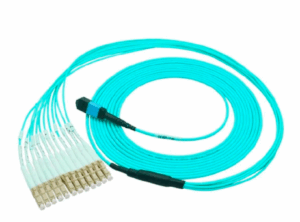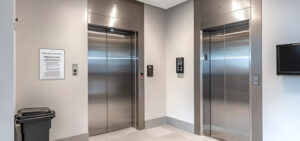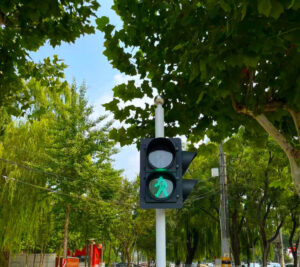Fan out cable plays a vital role in fiber optic infrastructure, enabling efficient distribution and termination of multiple fibers in a compact and manageable form. A fan out cable consists of a multi-core fiber optic cable whose fibers are separated or “fanned out” into individual strands, making them ready for direct termination or splicing.
This structure reduces installation time, provides mechanical protection, and supports reliable signal transmission for various network applications, including data centers, telecommunication backbones, and campus networks.
Table of Contents
ToggleOverview of Fan Out Cable
A fan out cable converts a multi-fiber cable into individual fibers for easy termination and connection. It is often used to split backbone cables with 12, 24, or 96 fibers into separate lines for patch panels or network devices. Each breakout fiber is typically 0.9–2 mm in diameter, while the main cable ranges from 3–12 mm depending on fiber capacity.
(1)Structure and Characteristics
Fan out cables often include an outer jacket made of LSZH or PVC for indoor use and polyethylene for outdoor installations. Inside, aramid yarn or fiberglass rods act as strength members to handle pulling forces of around 300 to 600 newtons for standard indoor designs. The minimum bend radius typically follows a rule of ten times the outer diameter to avoid signal loss caused by microbending.
(2)Key Functions of Fan Out Cable
- Simplified Termination
Fan out cables make it possible to directly terminate individual fibers without additional fan out kits. This is particularly useful in high-density environments where dozens of fibers may need to be connected in a limited space.
- Enhanced Fiber Management
By organizing multiple fibers within a single sheath and then distributing them into separate strands, fan out cables reduce clutter, improve airflow in racks, and minimize the risk of tangling or damage during maintenance.
- Protection of Optical Fibers
Each breakout fiber is individually protected, reducing susceptibility to mechanical stress, bending losses, and environmental exposure. Outdoor-rated fan out cables may include water-blocking gels and UV-resistant jackets to withstand temperatures from -40°C to +70°C.
(3)Types for Fan Out Cable
Fan out cables are commonly terminated with three main connector types: MPO-LC Fanout Cable and MTP-LC Fanout Cable, each designed for specific applications and network requirements.
- MPO-LC Fanout Cable
An MPO-LC fanout cable splits a high-density MPO connector into multiple LC connectors, typically 12 or 24 fibers. It is widely used in data centers and high-speed networks to connect backbone trunks with LC-based devices, offering quick deployment, low insertion loss (around 0.35 dB for MPO, 0.2 dB for LC), and efficient space utilization.

- MTP-LC Fanout Cable
MTP-LC fanout cable patch cord is equipped with an MTP connector, which can be branched into multiple LC connectors.The products can be 4C MTP-LC fanout cable, 8C MTP-LC harness cable or 12C MTP-LC breakout cable and the 12C MTP-LC is the most common one .It is an ideal choice for 10G-40G, 25G-100G, and 10G-120G network conversion.

Applications of Fan Out Cable
- Data Center Connectivity
In data centers, fan out cables are used to connect high-density backbone trunks to servers, switches, and patch panels. A single 48-fiber fan out cable terminated with LC or MTP connectors can replace dozens of single-fiber patch cords, saving space and reducing installation time by up to 40 percent.
- Telecommunications Networks
Telecommunication providers deploy fan out cables in fiber-to-the-home (FTTH) and metro network architectures. For example, a 12-core fan out cable with SC connectors may distribute signals from a feeder cable to multiple splitters, reducing splicing complexity.
- Industrial and Harsh Environments
Outdoor fan out cables with MTP or SC connectors are used in railways, oil refineries, and smart city infrastructure. They are designed to maintain low insertion loss, typically less than 0.3 dB per connection, even under vibration or humidity exposure.
Advantages of Fan Out Cable
Using fan out cable offers several significant advantages:
- It reduces the need for separate fan out kits, lowering both material and labor costs.
- It minimizes installation time compared to traditional splicing, often cutting it by nearly half.
- It supports scalability, with options from 4 to over 144 fibers depending on network growth needs.
- It provides better fiber organization, improving long-term maintenance efficiency.
- It ensures stable optical performance with minimal attenuation when installed within specified bend and tension limits.
Installation and Maintenance
- Installation Guidelines
Proper routing is essential to avoid exceeding the bend radius, typically ten times the cable diameter. During pulling, the rated tensile strength—commonly 300 to 600 newtons—should not be exceeded. Pre-terminated fan out cables often feature LC, SC, or MTP connectors, which require proper cleaning before insertion to prevent signal degradation.
- Maintenance Practices
Regular visual inspections of breakout points help identify potential strain or jacket damage. Optical time-domain reflectometer (OTDR) tests can be performed periodically to verify insertion loss and locate faults along the fan out cable. Clear labeling of fibers aids in future expansions or reconfigurations.
Future Trends in Fan Out Cable
- Expansion of Data Centers
Hyperscale data centers are adopting pre-terminated fan out cables with MTP connectors to support 400G and 800G Ethernet links. These high-density assemblies allow faster deployment and easier migration to higher bandwidths.
- Sustainable Design
Manufacturers are moving toward recyclable jackets, halogen-free materials, and energy-efficient production techniques to align with RoHS and REACH standards. This shift is expected to become standard practice as environmental regulations tighten globally.
Conclusion
Fan out cable is an essential element in modern fiber optic infrastructure, offering an efficient, organized, and scalable solution for connecting multiple fibers across a range of environments. From high-density data centers to outdoor telecommunication networks, its design simplifies termination, reduces signal loss, and enhances network reliability.
Fan out cables will continue to evolve, supporting higher fiber counts, smarter deployment methods, and more sustainable manufacturing practices.
0


